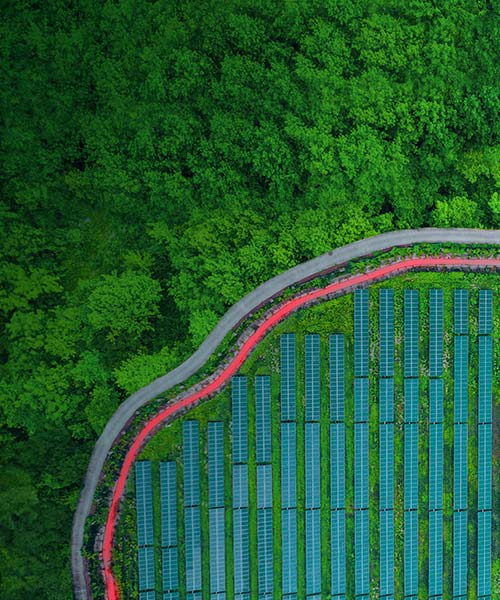May 26, 2022 • 3 min read
Power-to-X: What you need to know
Renewable energy is critical to global decarbonization efforts. But it can’t decarbonize the planet’s most energy intensive processes alone.
Renewable energy is part of the decarbonization story. However, some industrial processes, such as chemicals production, steelmaking, and long haul transport, require other fuels and feedstocks.
That’s where a combination of established and emerging technologies – called power-to-X – can fuel the most energy intensive processes on earth, without the CO2 emissions.
What is power-to-X?
Power-to-X solutions turn renewable electricity into something else of value. The power-to-X term covers a group of technologies and processes that convert typically renewable energy into different energy carriers or feedstocks. These include hydrogen, methanol, methane, and ammonia.
The range of power-to-X definitions include power-to-hydrogen, power-to-methane, power-to-ammonia, power-to-chemicals, power-to-fuel, power-to-gas, power-to-liquid, power-to-methanol, and power-to-power, to name a few.
Power-to-X is suited to situations where renewable energy supply exceeds demand. It enables electricity generators to turn their excess renewable energy into monetizable liquid fuels or gases. However, there is also an increasing number of projects that are looking at dedicated power-to-X solutions, and some of them are not grid connected.
How does power-to-X work?
Every power-to-X pathway begins with lower emissions energy. This typically include solar, wind, hydroelectric power, but can also include nuclear power.
The next step is to transport this electricity to an electrolyzer. This device is critical to all power-to-X pathways. An electrolyzer uses electrical energy to separate water into renewable hydrogen and oxygen.
The most straightforward power-to-X pathway ends here. It’s called power-to-hydrogen. Renewable hydrogen can provide a feedstock or fuel to various industrial activities such as refining and petrochemicals production, steelmaking, and long haul transport. And it doesn’t need any further processing after electrolysis.
In more complex power-to-X pathways, renewable hydrogen contributes to producing something else. This usually requires additional conversion steps to create higher value fuels and feedstocks.
For example, combining renewable hydrogen with nitrogen creates green ammonia. This is an important ingredient in chemicals and fertilizer production.
Other power-to-X pathways have more conversion steps. Energy producers can create synthetic fuels – or e-fuels – with almost identical properties to fossil fuels in the transport sector. This requires a synthesis of renewable hydrogen with CO2 to produce liquids, such as e-methanol, e-gasoline, or sustainable aviation fuel (SAF).
The renewable energy can also be returned to the electricity grid during shortages. By storing electricity as renewable hydrogen or green ammonia – through power-to-X pathways – this energy can fuel gas turbines to generate electricity or be used in boilers to generate steam and then electricity. This pathway is called power-to-power, and it’s a form of energy storage.
The opportunities of power-to-X
Power-to-X solutions provide a pathway for decarbonization. The end products – whether renewable hydrogen, synthetic fuels, green ammonia, or chemicals – reduce the need for fossil fuels in heavy industry. Power-to-X processes can therefore avert large volumes of CO2 emissions, so long as the energy intensive conversion steps are powered by lower carbon energy.
Another advantage of power-to-X is flexibility. Power-to-hydrogen, power-to-ammonia, and power-to-methane enable power generators to store their excess renewable energy for use in other industries. Or the stored energy can help to provide electricity for the power grid when weather conditions don’t suit renewable energy production.
Over time, power-to-X pathways are forecasted to become cost competitive with traditional energy sources. The cost of renewable energy and electrolyzers are falling. Meanwhile, the cost of crude oil, natural gas and coal are increasingly volatile and may be burdened with an increasing price of carbon in many jurisdictions. This is an ongoing challenge for energy intensive industries and businesses.
The future of power-to-X
The technologies to produce renewable energy, and extract renewable hydrogen, are already available. And each power-to-X pathway – from creating valuable gases to synthetic fuels to food products – is also technologically proven.
The missing link in the power-to-X story is scale. But with each new project, scale increases. And the growing scale will see lower carbon fuels and feedstocks reduce global dependence on fossil fuels.
Over the coming years, power-to-X pathways will operate alongside electrification to decarbonize the most challenging industries on earth. Every sustainable project in heavy industry brings net zero ambitions closer to reality.



